|
|
| Freewheeling Amsterdam |
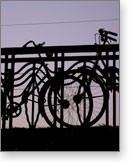 Photos by Renata Kosina
Photos by Renata Kosina
It was on a cappuccino break at Espresso Corner Baton on Herengracht that it hit me:
Amsterdam may be the most easygoing city in the world.
Wiping the scud of foam and ginger-cookie crumbs from my mustache, I breathed in air
freshly washed from a September rain. After zigzagging along the cobblestones, canals
and back streets on our rented and brutally ugly (but extremely efficient) Batavus
bicycles, soaking up the centuries-old ambiance of Holland’s vibrant city by the sea,
my muscles were tired but my brain was refreshed. It wouldn’t be until the day I left
that I fully understood what P.G. Brouwer, a charming cabbie, fully meant when he said,
"Amsterdam is the nicest city in Europe. There’s no stress."
BICYCLES RULE IN AMSTERDAM
There are about 600,000 bikes in the city, nearly one for each resident. That’s because
they’re better for negotiating the city’s flat, narrow streets, unimpeded by nothing taller
than the frequent bridge over the Amstel River or one of the city’s 165 canals. It’s a cyclist’s
dream.
But we’re not talking strictly recreation here. Bicycles are second only to legs for
transportation for mothers with multiple children (with strollers that snap onto bike frames),
businessmen and women dressed in workaday uniforms, police, students, pairs of teen girls
(one of whom rides side-saddle), everyone. Certainly there are autos, but with that many
cyclists circumnavigating the city, the pace is decidedly less than urgent.
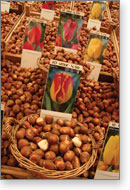 The trick is to pedal like a native. The orange and white MacBike logo sign on my handlebars
pegged me instantly as a foreigner, but my speed was the dead giveaway. Amsterdammers pedal
like they mean business. I meant pleasure. Yet road rage is little more than getting the
tinkle of a bell, the signal for watch your backside, there’s a local who wants by. Get
used to it.
The trick is to pedal like a native. The orange and white MacBike logo sign on my handlebars
pegged me instantly as a foreigner, but my speed was the dead giveaway. Amsterdammers pedal
like they mean business. I meant pleasure. Yet road rage is little more than getting the
tinkle of a bell, the signal for watch your backside, there’s a local who wants by. Get
used to it.
The city itself pulses with tolerance and well-being. Amsterdammers are in shape from all
that pedaling, but they’re also extremely tolerant when it comes to accepting things the way
they are. This open-mindedness can be as big as the city’s famed “coffeeshops,” beatnik-cool
examples of illegal-yet-tolerated indulgence, or as simple as on narrow streets, where it’s
not uncommon for a delivery truck or passenger car to stop and park to unload. Cars queue up
behind them patiently. Apparently everyone knows it happens and waits until business is concluded
and it’s time to move.
TWO WHEELS OF JOY
On a bike, Amsterdam becomes even more of a city of joyful discovery. In one day, if you’re
lucky, you’ll catch a blues festival in the heart of the red-light district, an art exhibition
in an idyllic park five miles up the Amstel River, a street market near the Amsterdam Zoo or an
outdoor photography display near the Waterlooplein.
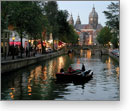 Special events aside, there are enough unique things to keep one occupied that the usual
tourist forays—the Anne Frank House, the Rijksmuseum, the Rembrandt House or the Royal
Palace—quickly become Plan B. Plan A is to pick a point and pedal there, stopping when your
interest is piqued beyond neglect. Distances are surprisingly deceptive. You can go much
further than you think just by looking at a map. Learn a few landmarks, and you’ll be
navigating like a local.
Special events aside, there are enough unique things to keep one occupied that the usual
tourist forays—the Anne Frank House, the Rijksmuseum, the Rembrandt House or the Royal
Palace—quickly become Plan B. Plan A is to pick a point and pedal there, stopping when your
interest is piqued beyond neglect. Distances are surprisingly deceptive. You can go much
further than you think just by looking at a map. Learn a few landmarks, and you’ll be
navigating like a local.
Jos Louwman owns MacBike, a company he started 15 years ago to fill a void that he couldn’t
help noticing. After traveling in India, mostly by bicycle, he thought it was strange that
a city like Amsterdam had few, if any, good bike rental shops. He now owns three shops that
offer rentals and two that handle repairs and storage. He built the business on backpackers,
but it has grown to include the habitués of five-star hotels, the huge traffic that passes
through the city’s monstrous Centraal Station, and anyone who needs two wheels for a day, a
week or a month. “The Queen [Beatrix] rides a bike,” says Louwman, a lean, easygoing man with a
ready smile. “Amsterdam has a tradition of transport, instead of recreation.”
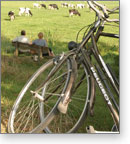 For recreational riders, two things must be kept in account. “Safety is the main thing,”
Louwman says. One must always watch out for the tram and rail tracks that slither through the
city, as well as the traffic. Secondly, thousands of bikes are stolen each year. Many measures
have been taken to help curb the problem, such as the sheer ugliness of the bikes and a
dual-locking system that includes a heavy chain or cable lock with which you affix your bike
to something immovable, and another key lock on the back tire that, when secured, makes the
bike unrideable.
For recreational riders, two things must be kept in account. “Safety is the main thing,”
Louwman says. One must always watch out for the tram and rail tracks that slither through the
city, as well as the traffic. Secondly, thousands of bikes are stolen each year. Many measures
have been taken to help curb the problem, such as the sheer ugliness of the bikes and a
dual-locking system that includes a heavy chain or cable lock with which you affix your bike
to something immovable, and another key lock on the back tire that, when secured, makes the
bike unrideable.
Linda, our MacBike attendant, introduced us to the locking system with a reminder:
“Six hundred bikes a day are stolen. Use a little common sense.” And within minutes,
we are pedaling toward the Blue Bridge and a carefree ramble up the Amstel.
UP THE AMSTEL
If Amsterdam is a heart, the Amstel River is its blood. It’s a fluid ribbon that wends
its way into the city along dikes and through verdant lowland. An easy 20-kilometer loop can
take one up to the village of Ouderkerk and back down, with stops at art galleries, a couple
of archetype windmills, Amstel Park and riverside cafés.
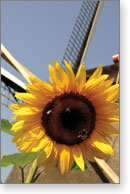 Bike lanes in and out of Amsterdam are plentiful and well-marked. The trip is part urban,
part pastoral idyll. Just a short way outside of city proper, the ride turns to country. Verdant,
lush farmland with fields of cows and the occasional heron make for a pleasant ride.
Bike lanes in and out of Amsterdam are plentiful and well-marked. The trip is part urban,
part pastoral idyll. Just a short way outside of city proper, the ride turns to country. Verdant,
lush farmland with fields of cows and the occasional heron make for a pleasant ride.
My ride being on a fair-weather Sunday, the river is busy with fishermen with long poles,
boaters and city folk relaxing in folding chairs with picnics and Sunday papers. Wester Amstel
Park hosts an art exhibit with works by artist Ina Berends, whose watercolors are lovely
depictions of the countryside. “I’m inspired by this area,” she says. “It’s very beautiful,
with all the flowers.” We agree.
IN THE CITY
Downtown Amsterdam is laid out in rings, along several major canals. You can’t go wrong
circumnavigating the rings, as they ebb out from Centraal Station along major canals. One
could ride loops all day.
We catch an outdoor exhibit of stunning aerial photography by Yann Arthus-Bertrand, near
Waterlooplein and the Stadhuis, as well as the well-worn Waterlooplein street market. One
can easily ride to the man-made islands of Java and Borneo, with their modern architecture
and eye-dazzling footbridges, and in the same day easily take in Artis Park and the Amsterdam
Zoo, and the Ten Kate Markt, a pleasant surprise on Ten Kate Straat, which is open every day.
Or take in the Bloemenmarkt, the floating flower market and a riot of color and smell that
dates back to the 1870s. Or the Huis Marseille, a prime example of canal-house finery that now
houses an international photographic exhibit.
 We take great delight in finding the out-of-the-way places, like Begijnhof, a cloister of
300-year-old homes and a small church, with a center courtyard that offers a quiet and
well-landscaped retreat away from the harried city streets. The entrance can be hard to spot,
despite your best map reading. “You must go around the corner,” a polite Dutch woman told us as
we stood befuddled looking for the proper doorway. “It’s very nice, very quiet, with a small
chapel, where you can light a candle.” The entrance is at Gedempte Begijnensloot and Begijnsteeg.
Can’t understand why we got confused.
We take great delight in finding the out-of-the-way places, like Begijnhof, a cloister of
300-year-old homes and a small church, with a center courtyard that offers a quiet and
well-landscaped retreat away from the harried city streets. The entrance can be hard to spot,
despite your best map reading. “You must go around the corner,” a polite Dutch woman told us as
we stood befuddled looking for the proper doorway. “It’s very nice, very quiet, with a small
chapel, where you can light a candle.” The entrance is at Gedempte Begijnensloot and Begijnsteeg.
Can’t understand why we got confused.
On any excursion around Amsterdam, one invariably passes hundreds of canal barges converted to
homes on nearly every waterway. No two are alike. We discovered some living history at the
Woonboot (Houseboat) Museum on Prinsengracht. Converting the old barges to homes was the fashion
in the 1960s, since there were a surplus of houseboats floating around. Though the city now limits
the number of houseboats to the current number of 2,500, they come up for sale frequently. Rental
space is cheap, but the boats are not. Vincent van Loon opened up the museum due to the frequency
of people asking to see his houseboat. A former schoolteacher, van Loon says, “Now, this is my
job. So many people wanted to see the inside.” We did and wanted to instantly put down earnest
money.
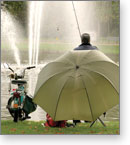 The stop is just another small adventure in a city that’s full of them. They have a word in
Dutch—gezellig—that’s hard to translate. It roughly means cozy, homey and friendly. A week
on wheels in this gentle city, with stops for the visual, the gastric, the sweet and civilized
indulgence, is all the translation you need.
The stop is just another small adventure in a city that’s full of them. They have a word in
Dutch—gezellig—that’s hard to translate. It roughly means cozy, homey and friendly. A week
on wheels in this gentle city, with stops for the visual, the gastric, the sweet and civilized
indulgence, is all the translation you need.
EDITOR’S PICKS
Where to stay
Renaissance Amsterdam Hotel
31.20.6212223
Centrally located, well appointed, impeccable service.
Ambassade Hotel B.V.
31.20.5550222
Ten 17th-century canal-side houses form the stylish surroundings.
Where to eat
Espresso Corner Baton
31.20.6248195
Fabulous cappuccino and pastries, light lunches.
Café t’Smalle
31.20.6239617
Distinguished brown café, with old-world ambience.
Don Campbell is a frequent contributor to World Traveler magazine.

| |
|